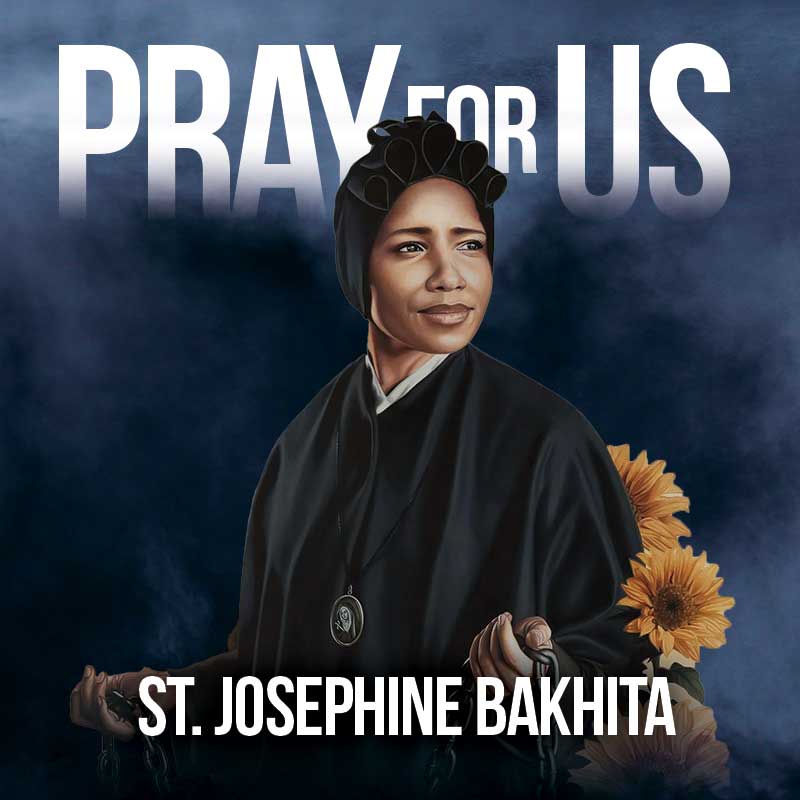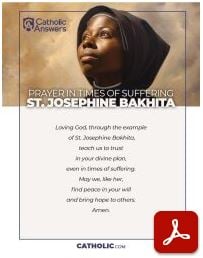
Who Was St. Josephine Bakhita?
Known as the patron saint of human trafficking victims, St. Josephine Bakhita’s journey from slavery to sainthood inspires Catholics and many others worldwide. Born in Sudan, sold into slavery, and later becoming a Canossian sister, her legacy reminds us of God’s power to bring good out of any suffering (see 2 Cor. 12:8-10; Rom. 8:28).
Q: What is St. Josephine Bakhita known for?
A: St. Josephine Bakhita is known for her incredible life, beginning with her being kidnapped as a child, sold into slavery, and brutally abused. In time, an Italian counsel in Sudan purchased her, treated her better, and took her to his homeland when she begged to go with him. In Italy, she became a Catholic, a nun, and, improbably, a great saint, one who continues to inspire many by her love and forgiveness in Christ, despite the terrible suffering she experienced in her life.
The Life of St. Josephine Bakhita | Early Life and Slavery
Born in 1869 in the village of Olgossa in Sudan, Josephine was kidnapped at age seven and sold into slavery by Arab traders. Her captors named her “Bakhita,” meaning “fortunate” in Arabic, though her life was anything but easy. She endured beatings and more than one hundred scars from her abductors and several owners, as she was sold several times on African slave markets. Somehow, though, she maintained hope amidst her hell on earth.
“As a slave I never despaired,” she said, “because I felt within me a mysterious force that supported me.”
After years of suffering, she was sold to the Italian consul in Sudan, Callisto Legnani, who treated her with kindness.
Journey to Italy and Religious Life
Josephine accompanied Legnani to Italy, where she lived with Augusto Michieli and his pregnant wife, becoming a nanny and friend to their daughter Mimmina when she was born. In time, Bakhita and her young friend traveled to Venice, living together with the Conossian Sisters of the Institute of the Catechumens. It was with the Sisters that Bakhita says she came to know the God whom, from her childhood, “she had experienced in her heart without knowing who he was” (see Acts 17:22-23).
“Seeing the sun, the moon, and the stars,” she recalls from her youth, “I said to myself, ‘Who could be the Master of these beautiful things?’ And I felt a great desire to see him, to know him, and to pay him homage.”
On January 9, 1890, she was baptized, confirmed, and received her First Communion, taking the name Josephine Margaret Fortunata, the latter name meaning “Bakhita” in Italian. She chose to remain with the Canossian Sisters rather than return to the Michieli family, a decision the Italian courts upheld in affirming her freedom.
From the Homily of Pope St. John Paul II
Sunday October 1, 2000
Abducted and sold into slavery at the tender age of seven, she suffered much at the hands of cruel masters. But she came to understand the profound truth that God, and not man, is the true Master of every human being, of every human life. This experience became a source of great wisdom for this humble daughter of Africa.
In today’s world, countless women continue to be victimized, even in developed modern societies. In St Josephine Bakhita we find a shining advocate of genuine emancipation. The history of her life inspires not passive acceptance but the firm resolve to work effectively to free girls and women from oppression and violence, and to return them to their dignity in the full exercise of their rights.
You can read the homily of Pope St. John Paul II for her beatification in 1992 (use Google Translate from Italian to English).
Religious Life and Vows
Josephine joined the Canossian Sisters in 1893 and took her final vows in 1896. She spent her life in service, inspiring many with her gentle spirit and deep faith. Despite long, painful years of sickness, which included physical and mental effects from her years of captivity, Josephine radiated peace and joy, uniting her suffering with those of her Lord Jesus Christ, in whom she experienced the incomparable serenity he promised his disciples (John 14:27). She died on February 8, 1947.
Canonization and Feast Day
Pope St. John Paul II canonized St. Josephine Bakhita in the Great Jubilee Year of 2000, a fitting choice because Jubilees are times of release and renewal in the Church. Her feast is February 8, a day dedicated to raising awareness about and remedying the scourge of human trafficking.
Q: Why is St. Josephine Bakhita the patron saint of human trafficking?
A: St. Josephine experienced slavery firsthand, and her triumph over such grave evil makes her a powerful intercessor for those suffering from human trafficking and related oppression.
Q: What did St. Josephine Bakhita do as a nun?
A: She served humbly as a Canossian sister, caring for the poor and teaching others about God’s love—including the freedom of forgiveness in Jesus—through her actions and words.
Prayers and Devotions to St. Josephine Bakhita
You can deepen your devotion to St. Josephine Bakhita through prayers and reflections on her life. Here’s a simple prayer to start:
St. Josephine Bakhita Prayer—Loving God, through the example of St. Josephine Bakhita, teach us to trust in your divine plan, even in times of suffering. May we, like her, find peace in your will and bring hope to others. Amen.
Why Do Catholics Pray to the Saints in Heaven?
Download the St. Josephine Bakhita Printable Prayer
Top 5 Facts About St. Josephine Bakhita
- Survivor of Slavery: Sold into slavery at a young age, she endured immense suffering before eventually finding freedom, especially as a Catholic in the Lord Jesus, the God she says she had yearned to know since her youth.
- Became a Nun: She chose to remain with the Canossian Sisters, dedicating her life to God.
- Patron of Human Trafficking Victims: Her life story inspires hope for those facing profound oppression, including gaining the power in Jesus to forgive one’s oppressors and pray for their repentance and conversion.
- Feast Day: Celebrated on February 8, her feast day highlights the fight against human trafficking.
- Canonized by Pope St. John Paul II: Officially declared a saint in 2000, she remains a model of faith, redemption, perseverance, and emancipation in the Lord Jesus through forgiveness of one’s enemies (see Matt. 5:43-48).
How St. Josephine Bakhita’s Story Inspires Catholics Today?

St. Josephine Bakhita’s life encourages us to see God’s hand in all circumstances (Rom. 8:28). Her story reminds us of the dignity of every human being and the power of forgiveness. As you reflect on her life, consider how her example can inspire you to act with compassion and merciful faith in your daily life.
Frequently Asked Questions About St. Josephine Bakhita
Q: How did St. Josephine Bakhita die?
A: She passed away after enduring years of painful illness, trusting in God to the end (see Phil. 4:13).
Q: Where did St. Josephine live?
A: She lived in Sudan and later Italy, including with the Canossian Sisters in Venice and elsewhere.
Q: What were the miracles of St. Josephine Bakhita?
A: The canonization-recognized miracles attributed to her intercession include the healing of a Brazilian women suffering from diabetes.
Celebrate the feast of St. Josephine Bakhita by learning about her story, asking for her intercession, and supporting efforts to end human trafficking. St. Josephine Bakhita, pray for us!
Additional Resources
Did the Church Ever Support Slavery?
Does the Bible Support Slavery?
Vatican News story of Josephine Bakhita (1869-1947).



